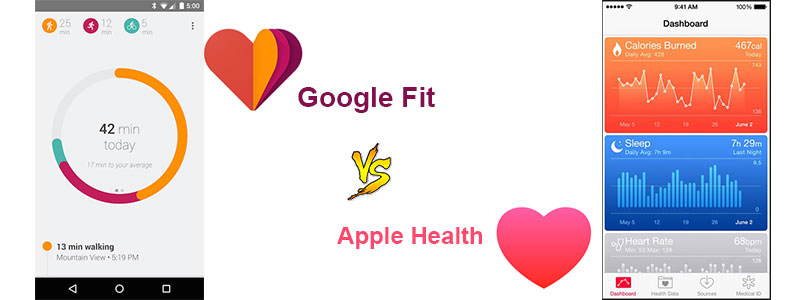 People are becoming more health conscious getting health apps and wearables. They understand that good health is above wealth. Both Google and Apple came up their Apple Health and Google fit apps respectively and are battling to be on top.
People are becoming more health conscious getting health apps and wearables. They understand that good health is above wealth. Both Google and Apple came up their Apple Health and Google fit apps respectively and are battling to be on top.
Google introduced the google fit in June 2014 as health-tracking platform. This was however a platform for developers earlier. It is a single set of APIs that blends data from multiple apps and devices. Google Fit uses sensors in a user’s activity tracker or mobile device to record physical fitness activities (such as walking or cycling), which are measured against the user’s fitness goals to provide a comprehensive view of their fitness.
Similarly Apple health is also an application intended to be a personal and central data collection point, for connected third-party electronic accessories and wearable technology, that can directly monitor and analyse an individual’s biochemistry and physiology for medical and general fitness purposes. It displays a dashboard of all the fitness and health data of the user, including the heart rate, calories burned, blood pressure, blood sugar, cholesterol, and other similar functions.
Lets find the difference between them.
How they works?
Google Fit provides Sensors, Recording, and History APIs needed for Google Fit integration. Developers connect various sensors from devices and wearables to their apps. The Recording API will allow apps to store data, like location, nutrition, workouts, and enable fitness apps to access the data created by any app. The fitness store is a cloud service that is transparent to clients. It is a central repository that stores data from a variety of devices and apps.
Google Fit provides a simple and user-friendly design. However you will have to swipe each time.
On the other hand Apple health is more comprehensive. It acts as one centralized hub or dashboard for all your health data from various third-party health apps, like wireless body scales, run trackers, sleep monitors, and more. Instead of opening up all these individual apps they feed all your health data to the Health app via framework HealthKit. The Healthkit, in turn, allows these third-party health apps to access your health data from other apps so each individual app can get a better picture of your overall health.
Features and data types
Google Fit divides the data majorly into 3 types – Public, Private and Shareable. These have further categorized into various activities. While Apple health data is divided into Characteristic, Sample, Source and Deleted.
Both of them covers different type of activity in which we’re participating, time active, distance traveled, steps taken, elevation climbed, calories burned, heart rate, height, weight etc.
However Apple Health goes some extra miles by storing more comprehensive data like our gender, blood type, workout intensity, known medical conditions, diet, and all of your sleep data.
Keeping it simple, google health keep tracks of important data only, but Apple health stores more comprehensive data.
Supported Apps
Most of the apps are available and are compatible with both android and IOS. Some of these are Nike+ Running, Map My Run, Strava, Runtastic, Withings, RunKeeper, fitstar, Endomondo etc.
Some of the big names in the health apps like Garmin, Jawbone, polar, Fitbit etc support either individual of both of them. For instance Garmin works natively with Apple health but not Google fit, However you can use compatible 3rd party app to use it with Google fit.
On the other hand polar supports both of them natively.
Compatible devices/ wearable
Google wear automatically plugs to google fit and google watch definitely supports Apple health. However there are many companies which are developing devices which works on both platforms.
The big guns in the wearable devices like Nike, Jawbone, Fitbit, Garmin, Basis either support one or both platforms.
Security
Your health information is safe and secure with both. The data is shared with 3rd party apps only after your permission. You can grant orrevoke apps access to use the data. Healthkit have your information stored in encrypted form. Google Fit defines OAuth scopes that map to three permission groups with separate read and write privileges: activity, location, and body.
Conclusion
I think both platforms are doing best to be on top and as a result we people are being benefited. Google focuses primarily on important aspects of health while Apple is more comprehensive and detailed and store more health aspects. So sticking to any platform would be good in my opinion. If you are Apple fan go for Healthkit otherwise google fit is also great to go.
What you think about Google Fit and Apple Health, please comment.
